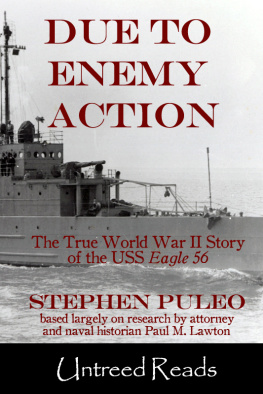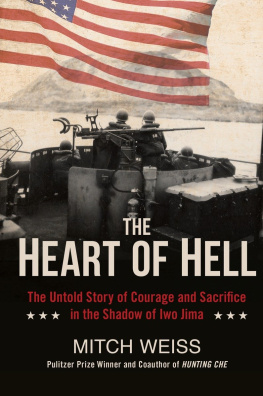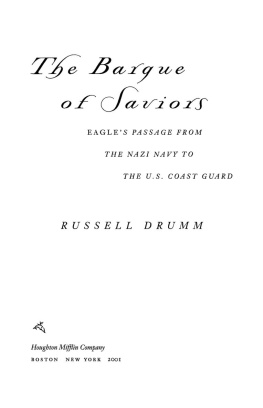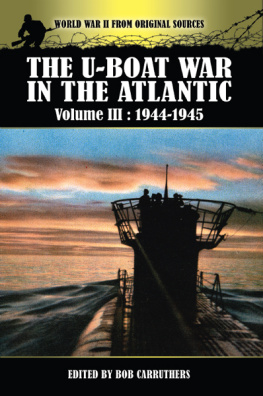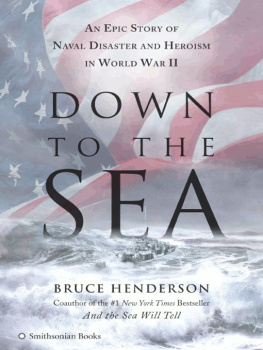DUE TO ENEMY ACTION
By Stephen Puleo
Copyright 2012 by Stephen Puleo
Cover Copyright 2012 by Ginny Glass and Untreed Reads Publishing
The author is hereby established as the sole holder of the copyright. Either the publisher (Untreed Reads) or author may enforce copyrights to the fullest extent.
This ebook is licensed for your personal enjoyment only. This ebook may not be resold, reproduced or transmitted by any means in any form or given away to other people without specific permission from the author and/or publisher. If you would like to share this book with another person, please purchase an additional copy for each person you share it with. If youre reading this book and did not purchase it, or it was not purchased for your use only, then please return to your ebook retailer and purchase your own copy. Thank you for respecting the hard work of this author.
http://www.untreedreads.com
DUE TO ENEMY ACTION
The True World War II Story of the USS Eagle 56
By Stephen Puleo
Based largely on research by Attorney and Naval Historian Paul M. Lawton
For the entire crew of the USS Eagle 56 (PE-56)those who died and those who survived on April 23,1945; especially for John Breeze, Harold Petersen, John Scagnelli, and Joseph Priestas, survivors who learned the truth.
And for World War II veterans James R. Lawton, and my father, Anthony W. Puleo.
Brave heroes all.
April 3, 1946
This office has been informed that, in view of the fact the investigating officers conducting the Board of Inquiry into the loss of the USS Eagle (PE-56) stated that the loss of this vessel was due to the explosion of its boilers, there is no authority for changing the status of the personnel from dead or injured not the result of enemy action, to dead or injured as the result of enemy action.
In view of the above, favorable action cannot be given to your request for the award of the Purple Heart to the personnel listed
Captain H. G. Patrick,
Navy Department Board of Decorations and Medals
To Lieutenant John P. Scagnelli, USNR, lone surviving officer of the USS Eagle PE-56
* * *
May 1, 2001
TO: Secretary of the Navy
FROM: Director of Naval History
Subj: Request for correction of historical record ICO [in case of] USS Eagle (PE-56) and recommendation of award of Purple Heart medals
I have determined compelling evidence and facts that support the correction of the historical record in the case of the loss of the USS Eagle (PE-56), sunk on 23 April 1945, by enemy action. It is further strongly recommended thata blanket authorization for the 49 crew members of the USS Eagle (PE-56) killed and those 13 eligible survivors, be awarded the Purple Heart Medal for death and wounds suffered in combat.
Contents
Honor and Redemption
Saturday, June 8, 2002
Quincy, Massachusetts
Aboard the USS Salem
Under a piercing blue sky, bright late-morning sun splashed across the main deck of the moored USS Salem and danced upon her gray anti-aircraft guns. High above the ship, white seagulls glinted as they wheeled in lazy circles amid faint cloud wisps. Light traffic thrummed across the short drawbridge nearby that traversed Quincys inner bay, and the Salems American flag whispered in the soft wind. A hushed crowd aboard the Salem listened as eighty-two-year-old John Scagnelli read the names of his former comrades, men who had perished on another warship, the USS Eagle PE-56, nearly six decades earlier. After each name, Scagnellis fellow Eagle 56 survivors, Johnny Breeze and Harold Pete Petersen, took turns tolling the ships bell in memory of men they had known in another lifetime, shipmates who would remain forever young.
Flanking Scagnelli, the invited VIPs sat ramrod straight, their chairs lined across a low platform stage, facing the families of the deceased Eagle 56 crewmen, loved ones who, in many cases, had traveled thousands of miles to attend this special ceremony aboard the Salem. A sprawling canopy shielded these relatives from the hot sun, protecting them as surely today as their fathers, brothers, grandfathers, and uncles were left vulnerable and exposed fifty-seven years earlier.
As the lone surviving officer of the Eagle 56, Scagnellis job was to read the names of the forty-nine men who had gone down with their ship in the final days of World War II, but as he neared the end of the list, his strong, clear voice caught in his throat and he blinked back tears. In his minds eye, he saw each of these young men, their faces flashing one after another, some smiling, most still in their twenties, and he was overcome with emotion. With Scagnelli literally unable to speak for a few moments, Breeze and Petersen struck the clapper against the bell again and again, pausing a respectful two seconds between each. The clarity and resonance of each peal reverberated across the Salems decks and into the harbor beyond, until finally the forty-ninth clang faded like a memory in mournful tribute to those crew members of the Eagle 56 who never returned home from World War II.
On April 23, 1945, just two weeks before Germanys surrender, the Eagle 56 had sailed from the U.S. Naval Frontier Base in Portland, Maine, at 8:15 A.M., with sixty-two men aboard. She had been towing a target buoy at the end of a 500-yard line for naval aircraft bombing exercises. With the war in Europe nearly over, Navy and Marine pilots practiced to stay sharp in case they were needed to fight the Japanese in the Pacific.
Shortly after noon, with the Eagle 56 at a dead stop less than five miles southeast of Cape Elizabeth off the rocky Maine coast, she suddenly exploded amidships, sending a geyser of steam and water two hundred feet skyward. She broke in half and sank within minutes. Forty-nine men perished in the terrible blast, either from the explosion itself or from drowning in the frigid waters of the North Atlantic. Of the Lucky Thirteen who survived, only Scagnelli, Petersen, and Breeze were still alive in 2002. Each of them, along with their ten shipmates who had been pulled from the water by rescue ships, had testified in 1945 as part of a hastily convened and clearly biased Court of Inquiry (COI) investigation, which ultimately concluded that a faulty boiler had caused the explosion. Soon afterward, the Navy modified its findings, officially attributing the destruction of the Eagle 56 to undetermined causes.
The Lucky Thirteen knew otherwise. As they plunged into the icy North Atlantic to save themselves, their ship torn in two, several men spotted a German U-boat thatagainst all rules of engagementhad surfaced near the wreckage of the Eagle 56. Even those men who did not see the U-boat testified unanimously that the rocking, concussive power of the blast left little doubt in their minds that it was caused by an external force, either a torpedo or a mine, but certainly not by a ruptured boiler. The thirteen survivors also knew, and many testified, that the Eagles boilers and engines had been completely overhauled two weeks earlier, and were in perfect working order.
Yet, their accounts were ignored by the Court of Inquiry and the Portland commander. The Navy brass, while skeptical of the COIs findings, was reluctant to overturn the official ruling and went along with the decision. Top-secret U.S. intelligence intercepts that showed a German U-boat, the U-853, prowling in the Gulf of Maine during April of 1945 were not declassified until many years later. Scagnelli, as the Eagles lone surviving officer, wrote condolence letters to the families of his dead comrades, but was prohibited from mentioning a cause for the explosion.
Next page
